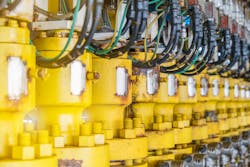Climate change is the defining megatrend of our time, influencing every segment of every industry in some way. That means every industry has some part to play in keeping global heating under the 1.5°C threshold set in the Paris Agreement—but few have as big a part to play as the oil and gas industry.
In particular, the downstream segment of the oil and gas industry is a significant contributor of the global heating problem. It emits significant amounts of methane and, according to the IEA, the downstream segment accounted for 20% of total fossil methane emissions. This means it has the potential to make a significant impact in the fight against climate change if it can get its methane emissions under control.
Finding an invisible threat
Methane is often compared directly to carbon dioxide, but the relationship between the two gases is complex. Methane’s molecular structure means it traps infrared (IR) radiation—heat—very effectively, much more so than carbon dioxide. It is estimated that, when first emitted into the atmosphere, methane traps 80–100X more heat than the equivalent amount of carbon dioxide.
But methane also has a much shorter lifespan once it is in the atmosphere—around 10 years— than carbon dioxide, which can persist for more than a century. This means methane emissions represent ”low-hanging fruit”—while emissions of methane are accelerating global heating at an unsustainable rate, cutting them will deliver rapid returns as humanity works toward achieving the sub-1.5°C target.
Failing to achieve this will result in the planet rapidly accelerating toward what is known as the tipping point, where the world enters a feedback loop and global heating becomes self-sustaining—and irreversible.
The problem is that tackling these emissions is easier said than done in the downstream segment. Most downstream methane leaks occur unexpectedly, a result of aging pipeline and storage infrastructure. And pipelines can run for miles, so checking for leaks can involve monitoring a vast area. Without using modern sensing technology, doing so is time-consuming and costly.
Thankfully, the technology required to address this is not some abstract future concept. It’s available now and is both affordable and effective.Laser absorption spectroscopy
Laser absorption spectroscopy is arguably the most powerful tool for promoting this understanding, because it has a particularly big role to play in tackling methane emissions. The IR-trapping property of methane molecules means they are prime targets for highly sensitive IR spectroscopy sensors.
While laser sensors can be designed for any region of the electromagnetic spectrum, many gas analysis devices operate in the IR. This is because many small gaseous species such as methane, carbon dioxide, and other hydrocarbons absorb IR light very strongly, which makes it easy to design devices with a sensitivity that extends into the parts-per-billion range.
Another advantage is that many different spectral lines characterize the absorption profile of these gases in the IR. Many features in the spectra can be used to identify chemical species with greater accuracy, and the information provided via laser sensors make gas analysis a powerful tool in industrial processing.
This form of detection is based on how light is absorbed as it passes through a medium. Emitters within the sensor generate beams of IR light that pass through a sampling chamber containing a filter. The filter only allows the required wavelengths—those reflected or emitted by the particles of gas being monitored—to make it past, so only those wavelengths can reach the detector. Different filters allow different wavelengths of light to reach the detector, which can, in turn, be used to detect different gases and distinct particles.
Newer gas analyzer instruments use a laser diode mounted on a thermoelectric cooler to tune a laser’s wavelength to the specific absorption wavelength of a particular molecule. They exploit their high-frequency resolution, which results in enhanced sensitivity—more significant levels of interaction between gas molecules and light on the order of parts per billion—and discrimination, because they are tuned to specific gas compounds. This lowers the risk of false alarms, which can become a serious issue with other common gas detection technologies.
The benefits of these sensors include fast response times and accurate results without using any additional gases to operate. Modern detectors can now continuously monitor for combustible gases and vapors within the lower explosive limit and provide alarm indications. These can be deployed within oxygen-deficient or enriched areas, require little calibration, and are immune to sensor poison, contamination, or corrosion.
Breaking the vicious cycle
Industrial gas detection is a mature market that continues to expand as devices become cheaper at the compliance end of the market and smarter at the top end. On the one hand, at Umicore, we work with OEMs stripping their devices back to basics, focusing on functionality and cost for low-cost markets. On the other, we assist in driving advances to open new opportunities and allow end users to use their devices in ways they haven't considered.
Through advanced gas detection deployed at both local and national levels, it is possible to not only detect leaks as they occur but also to provide more accurate data to inform climate policy. While satellite IR imaging paints a clear picture of methane emissions, it’s incomplete. IR energy can be disrupted by water, so offshore leaks or leaks that occur in humid areas can often go undetected. More widespread, localized methane sensors across pipelines, storage facilities, and transport hubs can help grow humanity’s understanding of methane emissions, and inform lawmakers of the best course of action.
As we move closer to the climate tipping point, the need to develop a clear, measurable strategy on methane is growing. This is simply impossible without having a solid foundation of actionable, up-to-date, or real-time data, giving researchers, governments, and businesses a complete picture of both anthropogenic and natural methane emissions—at both a macro and micro level.
Knowledge is power in all walks of life, but especially the fight against climate change. The facts about the true cost of the downstream oil and gas industry’s methane leaks are all out there—all we need is the tool to collect them. Laser absorption spectroscopy is that tool—and it could be the one that helps prevent a climate catastrophe.

